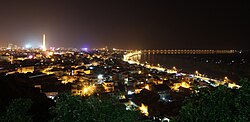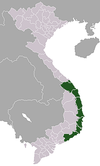Tuy Hòa
This article needs additional citations for verification. (November 2009) |
Tuy Hòa
Thành phố Tuy Hòa | |
|---|---|
| Tuy Hòa City | |
 The city at night | |
 | |
 Tuy Hòa Location of Tuy Hòa in Vietnam | |
| Coordinates: 13°04′55″N 109°17′42″E / 13.08194°N 109.29500°E | |
| Country | |
| Province | Phú Yên |
| Area | |
| • Total | 107 km2 (41 sq mi) |
| Population (2012) | |
| • Total | 202,030 |
| • Density | 1,888.1/km2 (4,890/sq mi) |
| Time zone | UTC+7 (Indochina Time) |
Tuy Hòa (![]() listen) is the capital city of Phú Yên Province in south-central Vietnam. The city has a total area of 107 km2 and a population of 202,030 (in 2012). The city is located approximately midway between Nha Trang and Qui Nhơn. The city is formulated mainly from alluvial of the downstream of Đà Rằng River. There are two mountains in the center of the city: Chóp Chài Mountain and Nhạn Mountain. Đà Rằng River and Nhạn Mountain create a poetic landscape. There is a Champa Temple on the top of Nhạn Mountain. Standing at this place, visitors can easily enjoy a full view of Tuy Hòa city.
listen) is the capital city of Phú Yên Province in south-central Vietnam. The city has a total area of 107 km2 and a population of 202,030 (in 2012). The city is located approximately midway between Nha Trang and Qui Nhơn. The city is formulated mainly from alluvial of the downstream of Đà Rằng River. There are two mountains in the center of the city: Chóp Chài Mountain and Nhạn Mountain. Đà Rằng River and Nhạn Mountain create a poetic landscape. There is a Champa Temple on the top of Nhạn Mountain. Standing at this place, visitors can easily enjoy a full view of Tuy Hòa city.
Infrastructure[]
Transportation[]
By air[]
The city is served by Đông Tác Airport which lies south of Tuy Hòa.
By land[]
Tuy Hòa Railway Station is a stop on the North-South Railway. National Route 1A runs through the city, providing road connections to Hanoi in the north and Ho Chi Minh City in the south.
Gallery[]

Tuy Hòa city view from Champa Temple on Nhan mountain

Tuy Hòa city view
Champa Temple on Nhạn Mountain
Climate[]
Tuy Hòa has a tropical savanna climate (Köppen climate classification: As).[1][2]
| hideClimate data for Tuy Hòa | |||||||||||||
|---|---|---|---|---|---|---|---|---|---|---|---|---|---|
| Month | Jan | Feb | Mar | Apr | May | Jun | Jul | Aug | Sep | Oct | Nov | Dec | Year |
| Record high °C (°F) | 33.7 (92.7) |
36.5 (97.7) |
36.3 (97.3) |
39.2 (102.6) |
40.5 (104.9) |
39.4 (102.9) |
38.3 (100.9) |
38.4 (101.1) |
38.4 (101.1) |
36.0 (96.8) |
34.5 (94.1) |
33.1 (91.6) |
40.5 (104.9) |
| Average high °C (°F) | 26.5 (79.7) |
27.7 (81.9) |
29.8 (85.6) |
31.9 (89.4) |
33.9 (93.0) |
34.1 (93.4) |
34.2 (93.6) |
33.9 (93.0) |
32.3 (90.1) |
29.6 (85.3) |
27.8 (82.0) |
26.4 (79.5) |
30.7 (87.3) |
| Daily mean °C (°F) | 23.1 (73.6) |
23.8 (74.8) |
25.3 (77.5) |
27.2 (81.0) |
28.8 (83.8) |
29.3 (84.7) |
29.0 (84.2) |
28.7 (83.7) |
27.7 (81.9) |
26.3 (79.3) |
25.2 (77.4) |
23.8 (74.8) |
26.5 (79.7) |
| Average low °C (°F) | 21.1 (70.0) |
21.3 (70.3) |
22.5 (72.5) |
24.0 (75.2) |
25.4 (77.7) |
25.9 (78.6) |
25.6 (78.1) |
25.5 (77.9) |
24.7 (76.5) |
24.0 (75.2) |
23.3 (73.9) |
21.8 (71.2) |
23.8 (74.8) |
| Record low °C (°F) | 15.2 (59.4) |
16.1 (61.0) |
16.4 (61.5) |
18.8 (65.8) |
21.4 (70.5) |
21.9 (71.4) |
21.7 (71.1) |
22.0 (71.6) |
20.9 (69.6) |
19.1 (66.4) |
17.7 (63.9) |
15.2 (59.4) |
15.2 (59.4) |
| Average precipitation mm (inches) | 57 (2.2) |
20 (0.8) |
25 (1.0) |
34 (1.3) |
77 (3.0) |
56 (2.2) |
45 (1.8) |
52 (2.0) |
234 (9.2) |
579 (22.8) |
454 (17.9) |
194 (7.6) |
1,826 (71.9) |
| Average precipitation days | 11.5 | 5.3 | 3.8 | 4.1 | 8.5 | 7.6 | 6.6 | 9.0 | 16.0 | 20.2 | 20.4 | 17.5 | 130.6 |
| Average relative humidity (%) | 84.1 | 84.5 | 83.7 | 82.3 | 78.8 | 74.9 | 74.4 | 75.7 | 81.0 | 86.0 | 86.2 | 84.8 | 81.4 |
| Mean monthly sunshine hours | 159 | 192 | 258 | 269 | 275 | 237 | 241 | 228 | 201 | 165 | 122 | 121 | 2,467 |
| Source: Vietnam Institute for Building Science and Technology[3] | |||||||||||||
References[]
- ^ Kottek, Markus; Grieser, Jürgen; Beck, Christoph; Rudolf, Bruno; Rubel, Franz (2006). "World Map of the Köppen-Geiger climate classification updated" (PDF). Meteorologische Zeitschrift. 15 (3): 259–263. Bibcode:2006MetZe..15..259K. doi:10.1127/0941-2948/2006/0130.
- ^ Peel, M. C.; Finlayson B. L. & McMahon, T. A. (2007). "Updated world map of the Köppen–Geiger climate classification" (PDF). Hydrol. Earth Syst. Sci. 11 (5): 1633–1644. doi:10.5194/hess-11-1633-2007. ISSN 1027-5606.
- ^ "Vietnam Building Code Natural Physical & Climatic Data for Construction" (PDF). Vietnam Institute for Building Science and Technology. Archived from the original (PDF) on 22 July 2018. Retrieved 20 July 2018.
- Populated places in Phú Yên Province
- Districts of Phú Yên Province
- Tuy Hoa
- Cities in Vietnam
- Provincial capitals in Vietnam
- South Central Coast geography stubs




